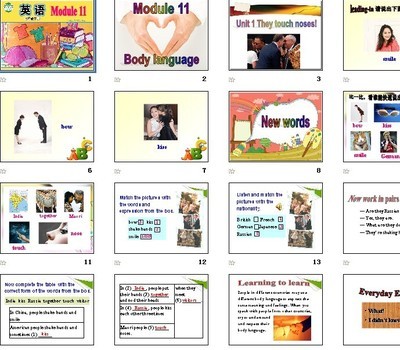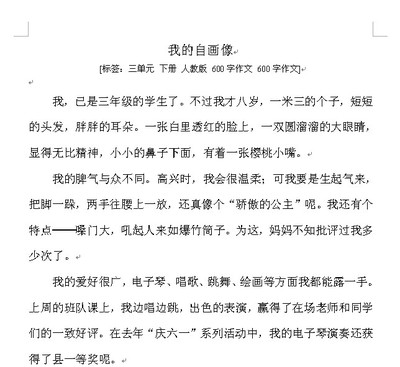BODYLANGUAGE
(ExtensiveReading)教学设计
I. The Analysis ofTeaching Contents
This is the second teaching period--ExtensiveReading in Unit 4 in New Senior English For China Student’s Book 4, in whichstudents can get the basic information about the body language indifferent culture through different reading skills.
Generally speaking, the students are quietfamiliar with the learning materials. However, they don’t haveenough knowledge about the background of different cultures. Thusthe teacher should give a bri ef introduction of body language indifferent cultures. Finally, the teacher should design someeffective and interesting activities to stimulate the students’interests and loves for learning bodylanguage.
II. TeachingAims
1. Knowledge aims
a. Useful new words and expressions
greet, represent, approach, expression, defend,misunderstand, adult, cheek, major, likely, in general
b. Spoken language
Act out the following meanings, please.
Please guess what I mean.
Please show the actions, using bodylanguage.
Please use either spoken words or body language toexpress your ideas.
2. Ability aims
a. Develop the students’ different reading abilitiesand let them learn different reading skills: skimming, scanning andcareful reading.
b. Help the students understand others when bodylanguage is being used.
3. Emotional aims
a. Let the students know the different body languagein different countries.
b. Stimulate the students’interests and loves for learning body language as well asto learn verbal language.
III. TeachingImportant Points
a. Let students get the detailed basic informationof the text, especially the structure.
b. Teach the students how to use body language inthe most appropriate occasions.
IV. TeachingDifficult Points
a. Let the students understand bodylanguage used in different countries or cultures as well as indifferent occasions.
b. Let the students know that there is bothpositive body language and negative body language.
V. TeachingMethods
a. Individual work, pair work and groupwork.
b. Skimming, scanning and carefulreading.
c. Task-based method and role-playingmethod.
VI. TeachingAids
Multimedia and othernormal teaching tools.
VII. TeachingProcedures
StepI.Lead-in
1. The teacher uses some pictures to arisestudents’ interests.
A furtherexplanation of the picture and lead in the topic of this unit—BODYLANGUAGE.
2.Invite all students to act the body languages.
Gesture | Meaning |
You are welcome. | |
Come on; be cheerful. | |
May you succeed! Or congratulations on your success! | |
I am not in favor of your idea or I’ll have to refuseyou. | |
He is very sad. | |
She is very happy. | |
They are waving goodbye to people around. |
Give a further explanation about the body languagewe used in our daily lives have the absolutely different meaningsaround the world.
Step II. Learningaims and Instructions
Showingthe teaching aims and Instructions on thescreen.
1. Learning aims
a. Enable the studentsto know different cultural body language when needed.
b. Help the students learn how to expressthemselves in body language to avoid misunderstanding inintercultural communication.
2. Instructions
Thestudents should prepare their textbooks, guiding papers,triple-color pens
and especially, their learningpassions.
Step III. Thecomments of the guiding papers
1. Strong points andshortcomings.
2. Encouragement
Step IV.Self-study
1.Check the answerstogether.
(1).Yesterday, another student and I,ouruniversity’s student association, went to the Capital InternationalAirport to meet this year’s international students.
(2).Tony Julia,her shoulder and heron the cheek.
(3).When we met yesterday, he movedmeas if I introduced myself.
(4).Most people around the world now greet eachother by, but some cultures use other greeting as well, such as theJapanese, who prefer to .
Suggested answers:
(1).Representing
(2).Approached, touched, kissed
(3). Veryclose to
(4). Shakinghands, bow
2.Let students read the sentences aloud.
Step V.Cooperatingstudy
1.Dividethe students into five groups and let them know their tasks andrequirements.
2.Discussin groups.
3.Invitethree students in different groups to show their achievements onthe blackboard.
Name | Description | Bodylanguage | Towhom |
Tony Garcia | Man from | ||
JuliaSmith | womanfrom | ||
AkiraNagata | man from | ||
GeorgeCook | man from | ||
AhmedAziz | man from | toman towoman | |
DarleneCoulon | womanfrom | shakehands and kiss twice on each cheek |
4.Anotherthree students give comments and solve students’ questions, ifnecessary. Then give fair scores.
5.Summaryby the teacher.
Addition:
This following chart is the key task forCooperatingstudy
Name | Description | Body language | To whom |
TonyGarcia | Man fromColombia | Kiss on the cheek | everyone |
Julia Smith | womanfrom Britain | no touching | everyone |
Akira Nagata | man fromJapan | bowing | everyone |
George Cook | man fromCanada | shaking hands | everyone |
Ahmed Aziz | man fromJordan | shaking hands nodding | toman towoman |
Darlene Coulon | womanfrom France | shakehands and kiss twice on each cheek | People she knows |
Step VI.Quiz
Judge the following statements whetherTURE or FALSE.
1.Thefirst person to arrive was Tony Garcia from Colombia.()
2.Juliaapproached Tony, touched her shoulder and kissed her on thecheek!
()
3.It isthe Japanese custom that people shake hands and then kiss eachother twice on each cheek when adults meet people theyknow.()
4.Menfrom Middle Eastern and other Muslim countries will often standquite close to other men to talk but will usually not touchwomen.()
5. English people do usually stand very close toothers or touch strangers as soon as they meet.()
Suggested answers:
(1).T
(2). F(Tonyapproached Julia, touched her shoulder andkissed her on the cheek!)
(3). F(It is the French custom that people shakehands and then kiss each other twice on each cheek when adults meetpeople they know.)
(4).T
(5). F(English people do not usually stand very close toothers or touch strangers as soon as they meet.)
Step VII.Role-playing
Invite some students to play My Thankful Heart to use bodylanguage to express themselves.
Step VIII.Assignment
Read the text after class and collect some information about bodylanguage in different cultures
The design of writing on the blackboard
Unit 4 Body Language
Name | Description | Body language | To whom |
Tony Garcia | Man from Colombia | Kiss on the cheek | everyone |
Julia Smith | woman from Britain | no touching | everyone |
Akira Nagata | man from Japan | bowing | everyone |
George Cook | man from Canada | shaking hands | everyone |
Ahmed Aziz | man from Jordan | shaking hands nodding | to man to woman |
Darlene Coulon | woman from France | shake hands and kiss twice on each cheek | People she knows |

 爱华网
爱华网

